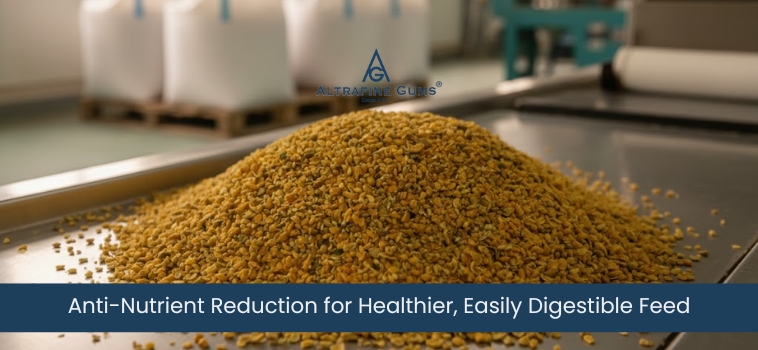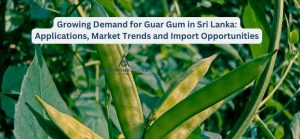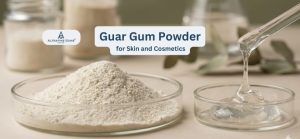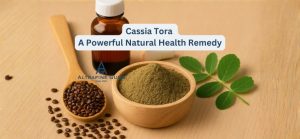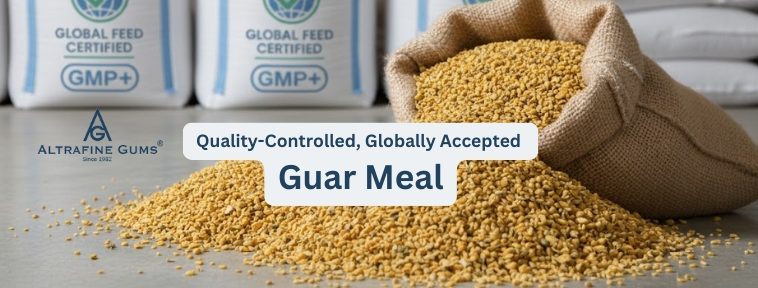
How Quality Control Ensures Safe, Nutritious, and Globally Accepted Guar Meal for Cattle Feed Industries
Table of Contents
Objective:
The objective of this article is to provide a comprehensive understanding of Guar Meal as a high-protein cattle-feed ingredient, focusing solely on livestock nutrition. It explains its nutritional value, the importance of quality control, the elimination of anti-nutritional factors, feed-grade safety testing, packaging stability, and the role of traceability in ensuring global market acceptance.
Guar Meal: A Critical Component in Modern Cattle Feed Systems
Guar Meal is increasingly becoming one of the most important plant-based protein sources used in cattle feed around the world. Derived as a byproduct from the guar gum manufacturing process, the meal consists of the endosperm-rich fractions-mainly Guar Korma and Guar Churi-that remain after gum extraction. These components are naturally high in protein, fiber, amino acids, and minerals, making them suitable for dairy cattle, beef cattle, buffaloes, and other ruminants. As global livestock industries face rising costs of traditional protein sources like soybean meal and fluctuating supplies of oilseed extractions, guar meal provides a stable, economical, and nutritionally advantageous alternative. Because the guar plant thrives in arid climates with minimal agricultural inputs compared to other crops, the meal is considered a sustainable option for large-scale feed production.
Nutritional Composition: Why Guar Meal Performs Well in Cattle Diets
The nutritional composition of guar meal is one of the primary reasons for its widespread adoption in global feed markets. Guar Korma, the protein-rich fraction, generally contains between 50–55% crude protein, making it a powerful feed ingredient for supporting muscle growth, reproductive performance, and lactation. Guar Churi, although slightly lower in protein (38–45%), provides an ideal balance of fiber and energy for improving digestive function in ruminants. The presence of soluble and insoluble fiber supports rumen microbial activity and helps cattle maintain stable digestion. In addition, guar meal contains essential minerals such as calcium, magnesium, potassium, and iron, which play a crucial role in structural bone health, immune response, and overall metabolic functioning. Because guar meal delivers an excellent balance of protein, fiber, and energy, many nutritionists and feed formulators incorporate it into cattle diets to reduce feed costs without compromising animal performance.
Quality Control in Guar Meal Production: Ensuring Reliability for Global Buyers
Quality control is the foundation of producing feed-grade guar meal that meets international expectations for consistency, safety, and nutritional value. The process begins with the sourcing of clean, mature guar seeds that meet strict agricultural standards. Seeds are inspected to ensure they are free from stones, husk impurities, excessive moisture, and insect damage. Once processed to extract guar gum, the residual meal undergoes controlled roasting, grinding, and sieving processes. Roasting is a crucial step because it helps reduce anti-nutritional factors, enhances digestibility, and improves the aroma and palatability of the meal—factors that directly influence cattle feeding behavior and nutrient absorption. Each batch of guar meal is then subjected to laboratory analysis to evaluate parameters such as crude protein, fiber, ash, moisture levels, and physical appearance. These standardized checks allow exporters and feed manufacturers to maintain consistency in quality even as global demand increases.
Eliminating Anti-Nutritional Factors: Improving Digestibility and Animal Health
Raw guar meal naturally contains certain anti-nutritional elements such as saponins, trypsin inhibitors, and residual gums, which can reduce digestibility when fed in unprocessed form. To address this, manufacturers use scientifically developed treatments such as intense heat application, roasting, and toasting. These processes help break down complex compounds and deactivate enzymes that interfere with protein absorption. Roasting also improves the texture and pleasant nutty aroma of guar korma, making it more appealing to cattle and encouraging better feed intake. In some advanced processing facilities, optional enzymatic treatments are employed to further enhance digestibility for high-performance dairy cattle. Through these interventions, guar meal becomes a highly digestible and safe ingredient that cattle can efficiently convert into energy, milk production, and overall growth.
Microbiological and Chemical Safety Testing: Meeting International Feed Regulations
Ensuring microbiological and chemical safety is essential when supplying guar meal to global livestock markets. Accredited laboratories conduct extensive testing on every export batch to verify the absence of contaminants and guarantee adherence to international feed standards. Microbiological tests check for pathogens such as E. coli, Salmonella, yeast, and mold, ensuring that the meal remains safe for long-term cattle consumption. Chemical analyses focus on detecting aflatoxins, pesticide residues, and heavy metals such as lead, arsenic, and cadmium. These elements must remain below the permissible limits defined by global regulatory bodies since contaminated feed can affect animal health and enter the dairy and meat production chain. Moisture analysis is equally important because high moisture can lead to mold growth and nutrient degradation during storage or transit. By conducting these inspections consistently, manufacturers maintain product reliability and safeguard their reputation in international markets.
Packaging, Storage, and Export Handling: Protecting Nutritional Integrity
Exporting guar meal requires meticulous packaging and storage protocols to preserve its nutritional value and prevent contamination. Typically, guar meal is packed in durable HDPE or PP woven bags with inner liners that protect the material from moisture exposure. For bulk shipments, FIBC jumbo bags ranging from 500 kg to 1 MT are used to support ease of transport and handling. These bags are designed to prevent moisture absorption and maintain the structural integrity of the meal during long-distance shipping. Storage conditions also play a crucial role: the meal must be kept in cool, dry, and well-ventilated warehouses to avoid spoilage. Continuous monitoring of humidity, temperature, and ventilation ensures that the product retains its protein content and physical quality until it reaches the end user. Many exporters implement pre-shipment verification processes, including bag weight checks, sealing inspection, and final batch testing, to maintain consistency and ensure that international buyers receive guaranteed-quality product.
Traceability and Documentation: Building Trust with Global Cattle-Feed Buyers
Traceability is an integral part of supplying feed-grade guar meal to global markets, as it allows buyers to verify and validate the product’s journey from raw material to final shipment. Traceability systems help record information such as the origin of guar seeds, production dates, processing temperatures, batch numbers, and testing results. This information becomes part of the documentation package exported with each shipment. Common documents include the Certificate of Analysis, Certificate of Origin, phytosanitary certification, non-GMO declaration, and feed-grade quality compliance reports. Global cattle-feed buyers-especially in regions with strict regulations-depend heavily on transparent documentation to ensure that the feed meets import norms and maintains consistent quality. A strong traceability system not only facilitates smooth customs clearance but also strengthens buyer confidence, leading to long-term business relationships.
Conclusion
Guar meal has emerged as a vital contributor to modern cattle-feed formulations due to its high protein content, digestibility, and cost-effectiveness. Its relevance continues to grow as livestock industries worldwide search for affordable and efficient plant-based protein sources. Through structured quality control, scientific processing methods, rigorous safety testing, and export-grade traceability, manufacturers ensure that guar meal meets the nutritional and safety expectations of global cattle-feed markets. As demand for reliable feed ingredients increases, guar meal remains one of the most dependable and commercially viable choices for cattle nutrition worldwide.
FAQs About Guar Meal
What is Guar Meal and why is it used in cattle feed?
Guar Meal is a protein-rich byproduct of guar gum processing, valued for its nutritional density, digestibility, and cost-effectiveness. It supports muscle development, milk production, and improved digestion in cattle.
How do manufacturers ensure the quality of Guar Meal for cattle feed?
Quality is ensured through controlled roasting, batch-level nutrient testing, microbial analysis, and consistent monitoring of moisture, texture, and protein levels.
What anti-nutritional factors exist in raw Guar Meal?
Raw guar meal contains saponins, trypsin inhibitors, and complex carbohydrates that may reduce digestibility, all of which are minimized through roasting and heat treatment.
What safety tests are conducted before exporting Guar Meal?
Batches undergo microbiological testing for pathogens and chemical analysis for aflatoxins, heavy metals, pesticide residues, and moisture levels.
Why is traceability important in global cattle-feed markets?
Traceability assures buyers that the product is safe, compliant, and consistently produced. It includes documentation such as COA, origin certificates, phytosanitary reports, and batch records.

CEO, Altrafine Gums
With over Four decades of expertise in the natural gums and hydrocolloids industry, Ajit Patel leads Altrafine Gums, a globally recognized manufacturer and exporter of Guar Gum Powder, Cassia Tora Powder (Cassia Gum Powder) and other Hydrocolloids. Under his visionary leadership, the company has built a strong reputation for quality, innovation, and reliability across the food, feed, pet feed, pharmaceutical, mining, oil drilling and cosmetic sectors.
Altrafine Gums has been serving global industries for decades with a focus on sustainable sourcing, research-driven production, and stringent quality control. Its wide product portfolio includes Guar Gum Powder, Cassia Tora Powder (Cassia Gum Powder) and other plant-based hydrocolloids that serve as key functional ingredients in diverse applications.
Ajit Patel’s commitment to excellence ensures that every product from Altrafine meets international standards of performance and purity. He is passionate about advancing the global reach of Indian hydrocolloids, fostering customer trust, and promoting eco-friendly, science-backed solutions that enhance product formulation and performance worldwide.






